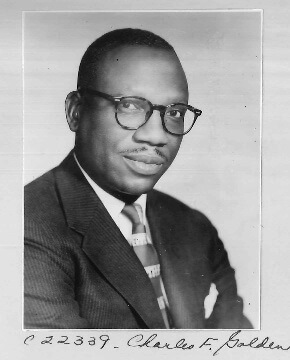
Board of Missions of the Methodist Church , “Mission Photograph Album - Portraits #10 Page 0133,” UMC Digital Galleries, accessed November 27, 2018, http://catalog.gcah.org/omeka/
items/show/61220.
Advocate of Integration in Methodism
Born August 24, 1912, in Holly Springs, Mississippi, Golden received degrees from Clark College and Gammon Theological Seminary, both in Atlanta. He was ordained an elder in the Methodist Episcopal Church (MEC) in 1938. He served several congregations in the South before becoming professor in the Department of Religion and Philosophy at Philander Smith College in 1938. He served as a chaplain in the U.S. Army from 1942 to 1946. After serving as director of field service in the Department of Negro Work of the Board of Missions from 1947 to 1952, he became the first African American named to the staff of the Board of Missions. He was associated secretary and later director in the Division of National Missions, where he served until 1960. He was a member of the General Conference Commission to Study the Jurisdictional System from 1956 to 1960, when he was elected bishop in the Central Jurisdiction. He presided over the Nashville-Birmingham Area 1960-1968 and in The United Methodist Church served the San Francisco Area 1968-1972 and the Los Angeles Area 1972-1980.
Just before the 1964 General Conference, Golden went with white Bishop James K. Mathew to worship at Galloway Methodist Church in Jackson, Mississippi. They were turned away, and their rejection was reported in the national news media. After the 1966 conference adopted an omnibus resolution proposing specific steps for merger of black and white conferences, the three annual conferences over which Golden presided failed to give approval. Golden emphasized through his articulation of issues and his episcopal leadership that Methodist African Americans would not settle for anything less than full and complete integration. Golden was noted as a forceful and even authoritarian bishop, but he was respected as fair and a person of integrity. He died in 1984.
Taken from Linda Gesling, Mirror and Beacon: The History of Mission of The Methodist Church, 1939-1968. (New York: General Board of Global Ministries, The United Methodist Church, 2005), p. 150




